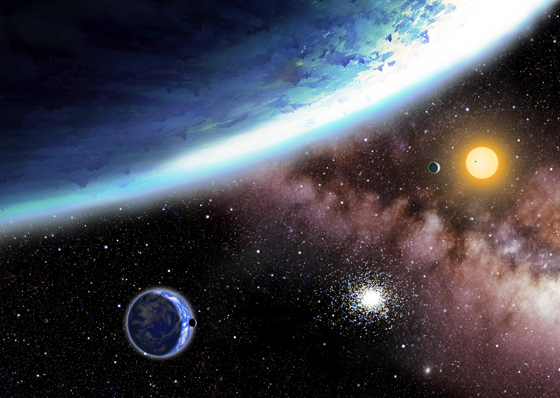Alien solar system got TWO EARTH-SIZED WORLDS. No word on mouth-breathing quasi-monkeys like us.
I say goddamn! Let’s all do what I am inclined to do: get excited over some astronomical theorizing based off of computer simulations! There ain’t nothing like mathematical calculations postulating about Earth-sized planets to get my nipples leaking mud.
Bad Astronomy:
Scanning the heavens, you might very well miss the star Kepler-62. It’s a rather typical star, slightly smaller, cooler, and more orange than the Sun, much like tens of billions of other stars in our galaxy. But it holds a surprise: It’s orbited by at least five planets… and two of them are Earth-sized and orbit the star in its habitable zone!
The two planets, called Kepler-62e and Kepler-62f, are both bigger than Earth, but not by much; they are 1.6 and 1.4 times the Earth’s diameter, respectively. Kepler-62e orbits the star every 122 days, while Kepler-62f, farther out, takes about 267 days.
Given the temperature and size of the parent star, this means that both planets are inside the zone around the star where water on the surface could be a liquid. Now, to be clear, this depends on a lot of factors we don’t know yet: the masses of the planets, their compositions, whether they have atmospheres or not, and what those putative atmospheres are made of. For example, Kepler-62e could have a thick CO2-laden blanket of air, making its surface temperature completely uninhabitable, like Venus.
Or it might not. We just don’t know yet, and won’t for quite some time—both planets are too small to get a measurement of their masses. It’s worth noting, though, that we do have size and mass determinations for a few planets like this around other stars, and they look rocky, like Earth. That makes it likelier these two planets are as well.
Also, the best computer models we have, based on what we know about how planets form and change over time, indicate that these planets could very well have water on them (it is, after all, incredibly common both in our solar system and in the Universe at large). We’ve already seen at least one planet with indications of the presence of water.
That’s pretty exciting. For years we didn’t know if any planets existed around other stars at all. When we started finding them all we could see were ones that were huge and hot, as unlike Earth as you can imagine. But as time went on, and our technology and techniques got better, we started finding smaller, less massive worlds. Now we are finding ones that look achingly like home.




